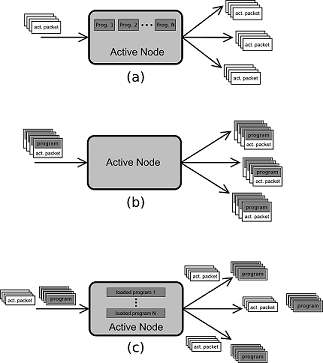Contemporary computer networks behave as a passive transport medium which delivers---or in case of best-effort service tries to deliver---data sent from the sender to the receiver. This simple but extremely fast passive forwarding paradigm can be changed into an active transport medium, which processes passing data based on data owners or data users' requests.
Because of many difficulties in establishing a novel networking infrastructure, the active networks have successfully employed the concept of overlay networks---the active network then consists of active nodes performing the user-defined processing over passing user data, and the passive networking infrastructure used for data transmissions (among the active nodes, or between boundary active nodes and user node(s)). The basic proposed active networks' concepts are:

(a) Active networks with fixed functionality -
these active networks enable a user to choose the function, which would be performed over her data, from a fixed router's functionality only (the required processing function is identified in data payload) and thus provides limited user-oriented processing only.(b) Active networks with embedded programs -
each active packet contains the whole active program that would be performed over packet's data.(c) Active networks with loadable functionality -
the most flexible approach, which enables its users to upload their own active programs into the active nodes before the data transmission, and perform them over passing data subsequently.
The active networks can be successfully employed in many applications -- new protocols/services development and employment, multimedia application processing (e.g., videoconferencing, video transcoding, video on demand, etc.), security services (data encryption over untrusted links, secure and reliable multicast, etc.), intrusion detection systems, and Intranet firewalls are just a few possible services which could be provided.
One of the areas, which our group mainly focuses on, is represented by the use of active networks for multimedia processing, and subsequent active networks' support for remote groups' collaboration (using videoconferencing tools). We have proposed a prototype of The Active Network Router, which follows the concept of active networks with loadable functionality, and which has later served as a basis for an introduction of user-controlled active element---a tool, which allows to overcome missing native multicast functionality by replicating passing data to a group of connected users, and which thus served us as a basis for videoconferencing applications. Its modular architecture further allows to extend its functionality by a set of modules, and thus to perform various user-driven processing (transcoding, scaling, moderating, etc.).
The boom in the virtualization---the reinvigorated technology, that has become one of the most talked-about technologies in recent years---lead us to extend the active router's architecture (the original active network router) in the way to support virtual machines (VMs), which can greatly increase the flexibility of its execution environment. By revising its architecture, we have proposed a new active node called DiProNN (Distributed Programmable Network Node, which combines the use of virtualization with another useful concepts---namely, with the component-based programming and the parallel/distributed processing. The node thus provides thus provides a powerful processing infrastructure, which allows its users to develop the active programs for arbitrary execution environments and comfortably compose them into complex processing applications.
Generally, besides many difficulties (e.g., performance/efficiency problems), there are many features that the virtualization concept brings to active networking, like strong isolation among the running applications and simpler attainability of robust security guarantees (both from the users' and nodes' point of view). Moreover, since the users are strictly isolated within the execution environments running in the VMs, they could be provided with administrative privileges without any degradation of nodes' security.
Information for students
The active networks' area (in general, the computer networks' area) provides many interesting research challenges---we would like to welcome all of you, who are interested in computer networks and who want to contribute with new ideas and contributions. Every applicant can participate via her work on bachelor or diploma thesis, via post-graduate studies or just simply via external collaboration on any of our projects. The IS MU provides several links to available bachelor/diploma topics, which are lead by the members of our research team---if necessary, new topics might be opened based on individual agreement.
National and International Collaboration
Our research group closely colaborates with many international institutions, the most important of which are:
- Louisianna State University, USA
- Electronic Visualization Laboratory, University of Illinois at Chicago, USA
Besides, we also colaborate with many national institutions and research teams:
- CESNET z.s.p.o., Zikova 4, Praha
- Institute of Computer Science, Masaryk University
Current grants
- Highly Parallel and Distributed Computing Systems, 2005 - 2011, research intent no. 0021622419, Ministry of Education, Youth and Sports, Czech Republic
- Large Infrastructure CESNET, 2004 - 2010, project no. LM2010005, Ministry of Education, Youth and Sports, Czech Republic
- Integrated Approach to Education of PhD Students in the Area of Parallel and Distributed Systems, 4/2005 - 12/2008, project no. GD102/05/H050, Czech Science Foundation
Research team
Head of research group:
Eva Hladká
Employees:
Petr Holub (ICS MU),
Miloš Liška (ICS MU),
Tomáš Rebok (ICS MU)
PhD students:
Vitalii Chepeliuk,
Milan Kabát
Bc. and Mgr. students:
Tomáš Kuba,
Ondřej Skipala
Contact
doc. RNDr. Eva Hladká, Ph.D.evar_b0=QLez@fiTmyPsOXSW.muniPysLCWDW=.cz